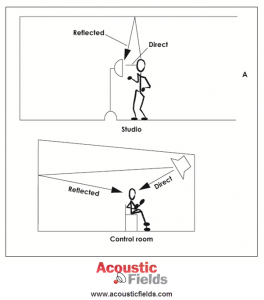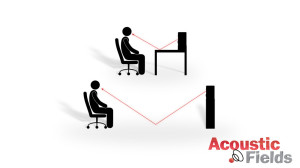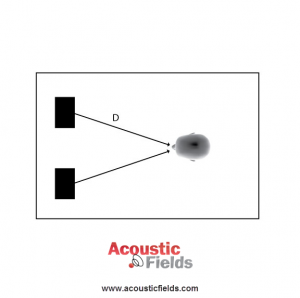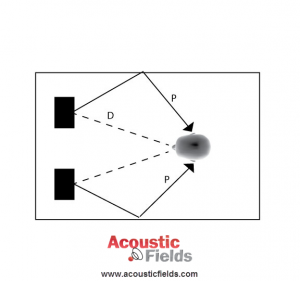Renew Your Room Acoustics, Part 2: Rays Are Reflections
This is the second article in a series by Dennis Foley of Acoustic Fields. See “Part 1: Waves and Pressure” here.
In the first part of this 6-part series, I discussed waves and rays of energy. Waves are all energy below 300 Hz. and rays are all energy above. Waves produce excess pressure within our rooms and rays add to the reflections from our room surfaces. I discussed how longer wavelengths will simply not fit into today’s smaller rooms causing many pressure related distortions. In this part 2, I will discuss rays and their contribution to room sound.
Rays Of Sunshine
Rays or energy that lies above 300 Hz. in our example, are made up of shorter wavelengths that comprise higher frequencies. Higher frequencies are much shorter in length and most will fit into today’s small rooms without causing too much pressure issues as we discussed with waves.
You can visualize rays by thinking about sunlight. They are thinner and shorter wavelengths, but contribute their own set of issues within our rooms. Rays bounce from surface area to surface area and all of this reflected energy contributes to what we call “room sound.“
Rays Are Reflections
When rays or energy above 300 Hz. within our rooms strikes a wall, it then continues on from the angle of incident towards another wall. Depending on the amount of energy it has left, it can continue on to other surfaces. This systematic assault on our room surfaces produces a series of reflections that, when are added up, cause the reverberation times that we have to deal with within our room.
Reverberation
High reverberation times can act similarly as high pressure within our rooms. High reverberation times can blur and smother certain frequency ranges especially with our middle and high frequencies. There is even a well-used measurement indicator called RT 60 times which represents the room’s ability to reduce its “power level”. The RT60 times are the measurement of time it takes energy to decay 60 dB in a room, and at what rate it does reduce.
Comb Filtering
Comb filtering is another room distortion that occurs in this reflection domain. When reflected energy interferes with the direct sound from our speakers, notches and peaks form as a result of this destructive interference. The reflections cross the straight line travel of the direct energy and produce jagged irregularities in the direct response curve.
The reflections can enhance certain frequencies and cancel others within the direct sound component of our signal. These jagged edges are called comb filters because the “teeth” look like those found in a comb. Comb filters are like room modes, only for higher frequencies.
Phantom Images
Comb filtering audible results are image and tonal corruption. The blending of numerous reflections with the direct sound from our loudspeakers produces a new phantom image and sound quality that is mired in timbre distortions and an overall reduction in signal clarity and quality.
This phantom image, if you will, that is layered upon the direct signal, conflicts with the wanted balance between direct and reflected energy at the listening or monitoring position and adds distortion that is audible.
Direct Energy
In our rooms, we have two main types of middle and high frequency energy that we are concerned about. We have the direct energy that travels in a straight line from our loudspeakers to our ears, and we have the reflected energy from our room surfaces or “room sound”.
It is always a balancing act to achieve the correct time signature with reflections, especially first order, in order to bring their arrival times in at the listening position, so that they are below that of the direct signal time signature.
Balancing Act
The balance between direct and reflected energy or “room sound” is different for different room usages.
A listening room will be more tolerant with reflections from side walls than a control room will be. A control room will want to minimize as much room sound as possible, so that all direct energy can be heard without room sound.
An engineer will want to hear everything that is going on in the mix. A listening room needs the room sound to compliment the audio presentation to add a sense of realism to the sound stage, while the control room wants only to hear what is in the mix. The room sound will have to wait until playback.
Reflection Time Signature
The time signature of the reflections from the side walls in comparison to the direct signal arrival times at the listening position has time windows, which can add or detract from image effects which are shifting and spreading related to spaciousness in the overall sonic presentation.
If the level of reflection is increased with the already time delayed signature, you can have shifts in the size and location of the central image in your sound stage. If you delay the reflection even further, the center image will be “pulled” in the direction of the most predominant reflection.
Spaciousness
Spaciousness comes under the reflection domain. If we assume a reflection delay of just 10 ms. below that of the direct signal, we are approaching a break point where the reflection becomes inaudible. If we increase it to 15 ms., we begin to hear it and in just this 5 ms. difference, we begin to create a sense of spaciousness in our mixes and presentations.
The listener is not aware that there is a balancing act occurring between direct and reflected energy to achieve the presentation they are listening to, if the setup is done properly keeping these reflection time windows in mind.
Direction Critical
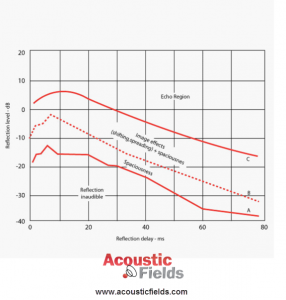
There’s a lot of information in reflections.
Reflections are so important in our musical presentations that the direction from which they occur is not that critical except in one very important location: If a reflection arrives at the listening or monitoring position from the same direction as the direct sound from a source such as a monitor, it can be heard through the direct sound. It can have a 5 – 10 dB impact over the direct sound.
Obviously, this cannot be tolerated in a control room environment! Front wall issues must be addressed.
Small But Powerful
Rays are shorter wavelengths that produce reflections in our small room music environments.
Reflections contribute to reverberation times in our rooms, which cover the room with more energy than it needs, thereby interfering with all facets of music reproduction.
Reflections from wall surfaces arrive at our listening positions and play havoc with the direct sound from our sources.
The time signature of reflections can add or subtract from out image focus, position, and clarity.
Reflections must be managed correctly with respect to the amount of impact they have upon our musical presentations.
Parts: 1-6
In Part One, we discussed waves and rays, and how each one contributes to pressure and reflection issues within our rooms. In Part Two of this series on Waves and Rays, we discussed rays and their contribution to reflections.
In Part Three, we will examine the technologies currently available for low frequency pressure management, and in Part Four we will examine middle and high frequency absorption technologies that minimize reflections from our room boundary surfaces. Parts 5 and 6 will discuss the application and positioning of these technologies for maximum sound quality.
About The Author
Dennis Foley is the Chief Acoustic Engineer at Acoustic Fields with over 30 years experience in the business. His technology has been used in Electric Lady Land Studios, Sony Music of New York, Cello Music and Films founded by Mark Levinson, and Saltmines Studios in Mesa, Arizona, along with hundreds of others. If you would like to learn more about room acoustics then be sure to subscribe to his YouTube channel for access to all his training videos and tutorials.
Please note: When you buy products through links on this page, we may earn an affiliate commission.







